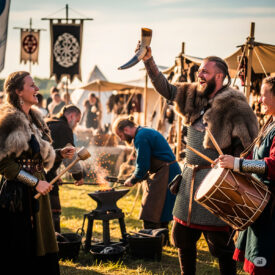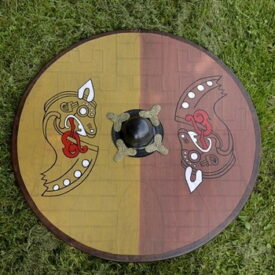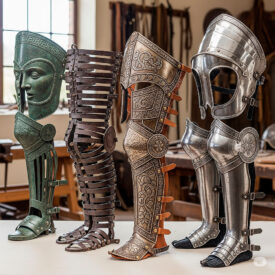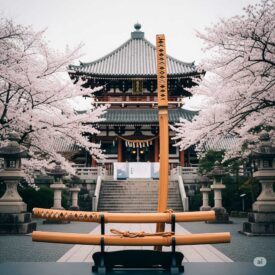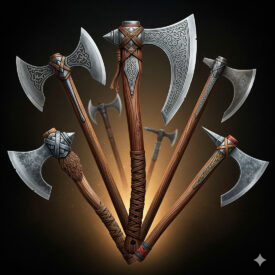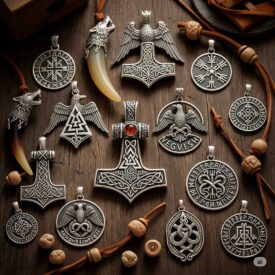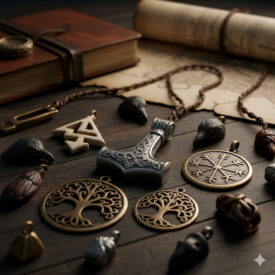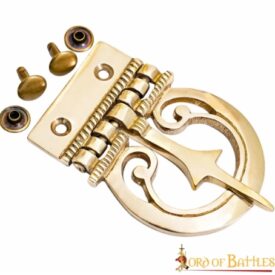Have you ever wondered how ancient Vikings conceived the universe? Beyond swords and longships, there was a complex web of myths and legends that gave meaning to their world. At the center of this worldview stood the imposing Yggdrasil, a cosmic tree whose branches, trunk, and roots intertwined the destinies of gods, giants, and men. Viking pendants, far from being mere ornaments, were portals to this mythical universe, carrying with them the essence of protection, wisdom, and interconnectedness.
Today, we invite you on a journey through time, exploring the profound meaning of Viking pendants and delving into the fascinating legends of Yggdrasil. You will discover how this majestic Tree of Life resonated with the spirit of the Norse people and how its symbols endure in our era, offering a connection to the strength and wisdom of an epic past.
Yggdrasil: The Pillar of the Norse Cosmos
At the heart of Norse mythology stands Yggdrasil, the World Tree or Tree of Life, a colossal force that sustains the universe and connects all its realms. This monumental ash tree, of immense proportions, extends its branches to the highest heavens, encompassing the totality of the cosmos and time.
What does the name Yggdrasil mean?
The name “Yggdrasil” is a kenning, a poetic rhetorical figure, commonly interpreted as “Odin’s horse.” The first part, “Ygg,” was a nickname for the god Odin meaning “the terrible” or “the fearsome one,” while “drasill” translates as “wanderer or errant,” or “horse.” Thus, Yggdrasil is also known as the “gallows of the hanged” or the “terrible tree,” names that allude to Odin’s sacrifice in search of wisdom.
Odin’s Wisdom and the Secrets of Yggdrasil
Mythology tells us that Odin, the All-Father, in his insatiable quest for knowledge, hung himself from Yggdrasil for nine days and nine nights. He pierced himself with his own spear, Gungnir, suffering voluntarily to unveil the secret of the runes, the ancient symbols of power and magic. The Vikings interpreted this act as a spiritual “ride,” a journey into the deepest realms of knowledge.
Furthermore, Odin sacrificed one of his eyes in Mímir’s Well, in Jötunheim, to drink from its waters and acquire unparalleled wisdom and intelligence. These stories, found in the Eddas (the *Poetic Edda* and the *Prose Edda* of the 13th century), are the primary source of our understanding of the Norse vision of the universe.
The Cosmic Structure: Nine Interconnected Worlds
Yggdrasil is not just a tree, but a cosmic axis that connects the Nine Worlds or realms of existence. Its branches, trunk, and roots act as bridges between dimensions, each housing different creatures and entities:
| Tree Zone | Worlds (Examples) | Function and Key Elements |
|---|---|---|
| Crown (Asgard) | Asgard (home of the Æsir), Vanaheim, Alfheim | Abode of the gods, including Valhalla, where Odin receives fallen warriors. |
| Trunk (Midgard) | Midgard (world of men), Jötunheim, Nidavellir, Svartalfheim | The terrestrial world. The trunk rises through these worlds. |
| Roots (Niflheim) | Niflheim (eternal ice and mist), Helheim (realm of the dead) | The roots plunge into the darkest depths, where mystical springs emerge. |
The three main roots of Yggdrasil extend to sacred springs:
- The Spring of Hvergelmir in Niflheim, from which the icy waters that nourish the eleven rivers flow.
- Mímir’s Well in Jötunheim, the spring of wisdom.
- The Urðarbrunnr in Asgard, the sacred well where the Norns (Urðr, Verðandi, and Skuld) water the tree with water and clay to maintain its vitality and weave the tapestries of fate.
Creatures of Yggdrasil: A Mythological Ecosystem
Yggdrasil is a universe in itself, inhabited by fantastic creatures whose interactions symbolize the balance between order and chaos:
| Creature | Location | Legend and Function |
|---|---|---|
| Níðhöggr (Dragon/Serpent) | In the roots, near Hvergelmir and Niflheim/Helheim | Grawer of the tree’s roots who seeks its destruction from below, spitting venom. It spits venom and tries to destroy it from below, representing destructive forces and the impulse towards chaos. It devours the corpses of murderers, liars, and traitors. It is in constant hatred with the eagle. |
| Nameless Eagle | In the crown, in the highest branches | Possesses profound wisdom, knowing everything that happens in the nine worlds. Maintains constant tension with Níðhöggr. |
| Veðrfölnir (Hawk) | Perches between the eagle’s eyes | Acts as the eagle’s “extra eyes.” |
| Ratatoskr (Squirrel) | Runs up and down the trunk | Acts as a messenger, carrying messages (mainly insults) between the eagle and the dragon, stirring up quarrels and sowing discord. |
| Víðópnir (Golden Rooster) | In the crown | Watches the horizon to prevent giant attacks and will awaken the warriors of Valhalla for the final battle (Ragnarök). |
| Deer (Dáinn, Dvalinn, Duneyrr, Duraþrór) | Grazing around the tree, eating its leaves and shoots | Represent the four directions or perhaps the seasons. The tree remains alive despite being fed upon, thanks to the Norns. |
| Heidrun (Goat) | Among the branches | Its milk feeds the warriors of the god Odin. |
The god Heimdall is the main protector of Yggdrasil, defending it from the attacks of Níðhöggr and the worms. The Norns, guardians of fate, also contribute to its care by constantly watering it, ensuring its cyclical rebirth.
The Fate of Yggdrasil: Ragnarök and the Rebirth of the World
Norse mythology predicts that Yggdrasil, despite its resilience, will not escape Ragnarök, the Viking apocalypse and the end of the world. In this final battle, it is prophesied that Níðhöggr will severely damage the tree, leading to the collapse of the entire cosmic system. However, not all is lost. Legends state that Yggdrasil will remain standing during the conflict and, after Ragnarök, will be reborn, bringing with it a new world. From its branches, the surviving human couple, Lif and Lifthrasir, will emerge to repopulate the Earth and build a better future.
Yggdrasil in Viking Jewelry: A Symbol of Eternal Connection
Yggdrasil was a crucial symbol in Norse culture, explaining natural phenomena and the course of life. Today, pendants inspired by this majestic tree are not just pieces of jewelry, but powerful amulets that carry the rich Viking heritage:
- They symbolize the interconnectedness of all things, the unity between heaven, earth, and the underworld.
- They represent the cyclic nature of life and rebirth, reminding us of constant evolution and renewal.
- They are a reflection of the quest for wisdom, inspired by Odin himself and his sacrifice for knowledge.
- They embody resilience and eternity, a reminder that, even after great cataclysms, life finds its way to resurge.
Wearing an Yggdrasil pendant is to honor the Viking worldview and connect with a legacy of strength, protection, and a deep sense of purpose. It is a reminder that we are part of a whole, a cosmic tree where every branch, every leaf, every root is intrinsically linked.
Yggdrasil in Viking Jewelry: Temporal Context and Meaning
Although there are no precise dates for Yggdrasil pendants, their context can be placed within Norse silversmithing and cosmology of the Viking Age and the literary sources that transmit it.
| Epoch | Event |
|---|---|
| Background (before the Viking Age) | |
| World Tree Motif | The motif of the cosmic tree connecting things predates the Viking Age and appears in various ancient cultures as a cosmological principle. |
| Viking Age (8th–12th centuries) | |
| Development of Viking jewelry | Jewelry and craftsmanship in jewelry, with mythical motifs, developed approximately between the 8th and 12th centuries. |
| Conventional period of the Viking Age | The Viking Age is usually dated between 793 and 1066 AD, a period of intense Norse cultural and commercial activity. |
| Yggdrasil Pendants | Pendants and pieces of jewelry depicting Yggdrasil were part of Viking cosmological symbolism; sources confirm their use but do not provide a clear start date for their employment as an amulet. |
| Comparison: Mjölnir (Thor’s hammer) | The oldest known representation of Thor’s hammer dates from between 800 and 900 AD; representations in pendants and amulets begin to be documented in the 12th century, providing a chronological comparison point with other motifs. |
| Literary Sources (13th century) | |
| Compilation of the Eddas | The main knowledge about Yggdrasil comes from the Eddas (Poetic Edda and Prose Edda), compiled in Iceland in the 13th century from oral traditions and previous sources. |
| Symbolic meaning in jewelry | |
| Cosmic connection | Yggdrasil represents the center of reality and the union of the nine worlds (Asgard, Midgard, Niflheim, etc.), symbolizing the interconnectedness of all things. |
| Cycle of life and destiny | Symbolizes the cyclic nature of existence: death and transformation. The Norns water the tree, linking it to destiny (Wyrd) and the flow of time. |
| Odin’s wisdom and sacrifice | The myth of Odin hanging from Yggdrasil for nine days to obtain knowledge of the runes connects the tree with the quest for wisdom and magical power. |
| Eternity and resilience | Yggdrasil is a symbol of durability; although it will be affected in Ragnarök, its destruction will lead to a rebirth of the world and of the gods. |
| Personal and symbolic use | Pendants with intertwined branches and roots served to express belonging to mythical traditions, connection with ancestors, and a deep sense of vital purpose. |
Clarifying doubts about Viking pendants and their symbolism
What is the historical origin of Viking pendants?
The historical origin of Viking pendants dates back to the Viking Age, approximately between the 8th and 11th centuries (793-1066 AD), when the Norse peoples of Scandinavia created jewelry that was much more than decoration: it served as a symbol of status, a religious amulet, and an element of cultural identity. Viking pendants emerged within this context as pieces that conveyed the Norse worldview and beliefs, including symbols such as Thor’s hammer, which represented protection and connection with the gods. These jewels were also used in funerary rituals and reflected the social position of their wearer, being mainly crafted in silver, gold, bronze or iron, and often included motifs inspired by mythology and Viking expeditions across Europe.
What other Viking symbols have deep meanings?
Other Viking symbols with deep meanings include:
- Valknut: Three intertwined triangles that symbolize warriors fallen in battle, the connection between life and death, and the power of the god Odin to guide those warriors to Valhalla. It represents strength, bravery, and the cycle of life and rebirth.
- Vegvisir: Known as the Viking compass, it is a symbol of guidance and protection that ensures the wearer will not get lost, especially on dangerous or stormy journeys.
- Aegishjalmur (Helm of Awe): An eight-armed star that represents magical protection and invincible strength in combat, inspiring fear in enemies and helping to overcome obstacles with the fortitude of the soul.
- Mjölnir: Thor’s hammer, a symbol of protection, power, and blessing, used for protection against evil, consecration, and to bestow strength.
- Odin’s Triple Horn: Three intertwined horns that symbolize wisdom and poetic inspiration, linked to Odin’s quest for the mead of poetry.
These symbols not only had decorative value but also represented spiritual beliefs, protection, strength, and the connection with the Viking gods and destiny.
How is Yggdrasil represented in modern popular culture?
 In modern popular culture, Yggdrasil is generally represented as an enormous cosmic tree that connects different worlds or dimensions, symbolizing the tree of life and the entire universe. It frequently appears in video games, movies, and series as a portal between realms or as a source of power and wisdom. For example, in the series American Gods it is shown linked to mythology and in the God of War saga it serves to travel between worlds, in addition to appearing in other fictions such as Vikings and various popular video games.
In modern popular culture, Yggdrasil is generally represented as an enormous cosmic tree that connects different worlds or dimensions, symbolizing the tree of life and the entire universe. It frequently appears in video games, movies, and series as a portal between realms or as a source of power and wisdom. For example, in the series American Gods it is shown linked to mythology and in the God of War saga it serves to travel between worlds, in addition to appearing in other fictions such as Vikings and various popular video games.
This tree maintains the original idea of Norse mythology about the interconnectedness of the cosmos, the cycle of life and death, and the pursuit of profound knowledge, adapting in popular culture to represent universes, destinies, and the balance between creation and destruction.
What animals are associated with Yggdrasil in Norse mythology?
The animals associated with Yggdrasil in Norse mythology are:
- A nameless eagle that lives in the crown of the tree.
- A hawk named Veðrfölnir that perches between the eagle’s eyes.
- A squirrel named Ratatösk that runs up and down the trunk carrying messages and insults between the eagle and the dragon.
- A dragon or serpent named Níðhöggr that gnaws at the roots of the tree.
- Four deer named Dáinn, Dvalinn, Duneyrr, and Duraþrór that graze on its branches.
Additionally, in some versions, the goat Heidrun is mentioned, feeding on its leaves near Valhalla, although not directly on Yggdrasil.
What other trees of life exist in different cultures?
Throughout the world, different cultures have associated the concept of “tree of life” with specific trees or have developed their own mythological interpretations:
- Norse Mythology: Yggdrasil, a giant ash tree that connects the nine worlds of the Norse universe.
- Serer Civilization: The Somb tree (Prosopis africana) is seen as the first tree on Earth and a symbol of immortality.
- Turkish World: The Ulukayın is a central symbol in Turkish mythology, representing rebirth and growth.
- Chinese Tradition: The Kien-Mou, a mystical tree that connects heaven and earth, symbolizing balance and wisdom.
- Celtic Culture: The “crann bethadh” represents the connection between heaven, earth, and the underworld.
- Ancient Mesopotamia: Considered the center of the universe, symbolizing the connection between gods and humans.
- Australian Aborigines: Symbolizes creation and connection to ancestors and nature.
- Ancient Egyptians: The acacia of Saosis is associated with Isis and Osiris.
- Saxons: The Irminsul oak was a pillar that supported the home of the gods.
- Mesoamerica: The ceiba and ahuehuete are sacred trees.
- Africa: The baobab is an emblematic tree in some cultures.
- Judaism and Christianity: The Tree of Life in the Garden of Eden symbolizes immortality and divine connection.
Trees of life and their symbolisms vary significantly between cultures, but they share the central idea of connection between worlds, wisdom, renewal, and the continuity of life.
VIEW MORE VIKING PENDANTS | VIEW CELTIC PENDANTS

